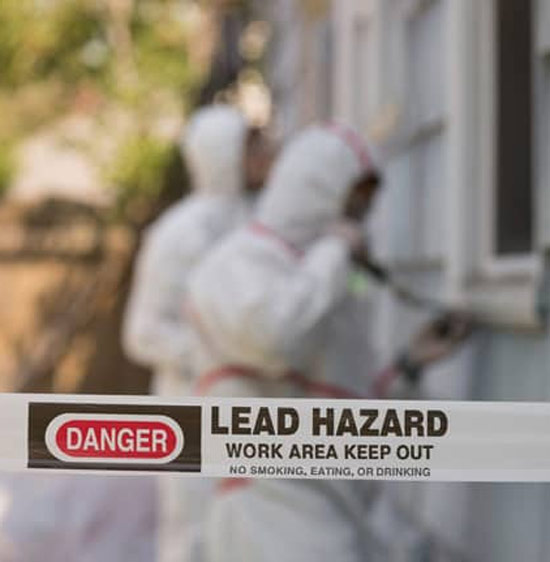DOH & HPD Lead Violation Removal NYC-- Specialist Services for Conformity
DOH & HPD Lead Violation Removal NYC-- Specialist Services for Conformity
Blog Article
Step-by-Step Refine for Successful Lead Infraction Remediation
Following this, adherence to federal and state guidelines is paramount to creating an efficient removal plan. The real removal calls for experienced personnel to carry out these plans while strictly following safety procedures. What happens after the removal is finished?

Detection and Assessment
Discovery and analysis are critical actions in the remediation of lead offenses. To ensure an effective removal process, it is vital to conduct an extensive exam of the atmosphere where possible lead direct exposure exists.
When discovery is achieved, a comprehensive analysis has to be embarked on. This includes assessing the degree and severity of contamination, in addition to recognizing populations in danger, especially youngsters and expecting women. Danger analyses often entail sampling and laboratory analysis, environmental surveys, and health influence researches. The collected data should be diligently recorded to support the growth of a reliable removal technique (Lead Violation Removal in NYC).
Moreover, it is critical to prioritize locations with the highest degree of contamination and those that present the biggest health and wellness risks. Efficient communication with stakeholders, including residential property proprietors, locals, and public health authorities, is vital for ensuring that all celebrations are educated about the searchings for and the subsequent steps needed for remediation. This preliminary discovery and analysis phase prepares for a successful lead offense removal process.

Legal and Regulative Conformity
Browsing the landscape of legal and regulatory conformity is a crucial element of effective lead infraction removal. Conformity ensures not just the security of damaged populaces however additionally the reliability and legal standing of the organization in charge of remediation. Laws controling lead contamination are diverse, incorporating government, state, and local laws. At the federal degree, the Epa (EPA) establishes strict standards under the Hazardous Materials Control Act (TSCA) and the Lead-Based Paint Restoration, Repair Service, and Paint Policy (RRP Guideline)
State and neighborhood laws can vary, typically enforcing additional responsibilities or more stringent requirements. For that reason, a thorough understanding of all relevant lawful frameworks is critical. This includes meticulous paperwork of all remediation tasks to demonstrate compliance. Failure to adhere to these guidelines can cause serious penalties, consisting of significant fines, lawsuit, and reputational damage.
Engaging lawful specialists focused on ecological law can promote navigating these intricacies. Normal training and qualification for all personnel included in the remediation process are likewise compulsory to ensure adherence to safety and security and governing requirements. By prioritizing lawful and regulative compliance, organizations can efficiently minimize dangers and achieve an effective removal result.
Planning the Removal
Properly preparing the remediation of lead offenses starts with a complete analysis of the polluted website. This data-driven technique makes certain that removal initiatives are properly targeted and reliable.
When the visit this web-site contamination is mapped, a risk assessment ought to be carried out to examine potential health and wellness dangers to people and the setting. Lead Violation Removal in NYC. This evaluation ought to think about variables such as direct exposure paths, populace vulnerability, and environmental influences. The understandings collected will certainly form the basis for selecting an appropriate removal strategy
Subsequently, setting clear, attainable objectives for the removal job is vital. These goals should straighten with regulatory criteria and stakeholder assumptions to guarantee compliance and neighborhood acceptance. Developing a comprehensive removal plan that outlines techniques, timelines, and source allotment will certainly facilitate a structured technique to the cleaning process.
Additionally, it is important to engage with stakeholders early and maintain clear communication throughout Recommended Reading the planning phase. This includes notifying local areas, getting essential authorizations, and collaborating with governing firms to make sure all lawful and procedural requirements are fulfilled. A well-crafted remediation strategy not just resolves the contamination successfully but additionally builds trust fund and teamwork amongst all parties included.
Performing the Removal
With a well-structured removal plan in place, the emphasis shifts to the actual implementation of the remediation activities. This phase includes mobilizing the needed resources, consisting of proficient employees, specialized devices, and top notch products. Begin by clearly marking roles and responsibilities to make sure responsibility and seamless coordination among staff member.
The first action in implementation is to safeguard the site. This includes establishing containment locations to prevent lead dust and debris from dispersing, in addition to employing air purification systems to maintain air quality. Next, wage the elimination of lead-based products. Utilize methods such as wet scratching, chemical stripping, or encapsulation, depending on the extent and place of the contamination. It is critical to comply with safety and security methods, including the usage of individual safety devices (PPE) and proper disposal of dangerous materials.
Throughout the removal procedure, conduct regular assessments and air top quality checking to make certain conformity with regulative standards. Effective interaction with stakeholders, consisting of property proprietors and occupants, is essential to keep them notified of progression and any unforeseen growths. By meticulously adhering to these steps, the remediation tasks can be implemented efficiently and effectively, inevitably mitigating lead dangers.
Post-Remediation Techniques
Post-remediation techniques play an essential function in guaranteeing the lasting success of lead offense remediation efforts. These strategies incorporate continuous surveillance, maintenance, and area education and learning to stop future lead exposure and ensure a risk-free setting.
First, routine monitoring is necessary. This includes regular testing of the previously impacted areas to guarantee that lead degrees continue to be within safe restrictions. Homeowner must develop a schedule for these examinations, preferably in partnership with qualified environmental experts.

Third, enlightening the community plays a critical function in maintaining the advantages of removal. Residents and home supervisors need to be notified concerning the risks of lead direct exposure and the ideal methods for keeping a lead-safe environment. Workshops, informational pamphlets, and area conferences can be efficient devices for distributing this details.
Final Thought
Successful lead offense removal requires a detailed, systematic strategy incorporating discovery and assessment of contamination, adherence to lawful and governing standards, careful planning, and reliable execution of removal efforts. Post-remediation approaches, including continual monitoring and neighborhood education and learning, are vital to sustain a lead-safe atmosphere. Collaboration with environmental experts makes certain browse around here recurring compliance and security of public health. This methodical procedure emphasizes the value of thoroughness and vigilance in resolving and minimizing lead contamination.
Report this page